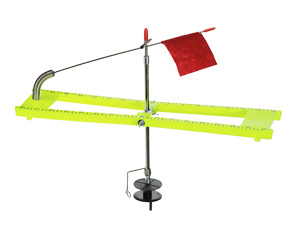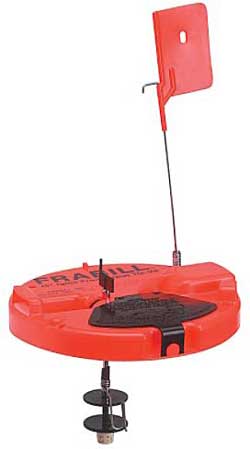
 |
| Anglers should never head to the ice to fish without taking a tip-up with them. |
In the most basic sense, a tip-up is one of the basic tools used when ice fishing. Tip-ups allow anglers to suspend live bait beneath the ice and detect fish strikes without having to maintain constant contact with their fishing gear. Tip-ups are a great way for anglers to spread out and effectively fish large bodies of water.
Tip-ups are effective for covering these large spans because once you have set them up, you can move to another part of the lake and keep fishing just by watching them from a distance. Pike, walleye and all types of panfish can be caught on tip-ups with just a few minor modifications to the leader and fishing hook size used for each respective species.
If you're in the market to purchase a tip-up or two, a few general considerations should be kept in mind to assure that you get the best product for your dollar. Above all else, a high quality tip-up is what anglers should look to purchase. These tools are going to be used in very harsh conditions, so a product that is strong, durable and made with quality materials will keep you fishing longer and as trouble-free as possible.
Quality Tip-Up Features
- Trip Bar — A trip bar is a simple design feature that allows the tip-up to be set for a heavy or light trip. This difference in trip settings allows anglers searching for smaller species to set the tip-up to a light setting so that smaller fish or very light bites can easily trigger the flag and alert the angler. The heavy trip setting on tip-ups is used for larger fish or very windy/gusty conditions that could possibly set off a false flag.
- Wide Stable Base — The tip-up base is a very important feature that most anglers overlook. The wider the base, the more stable. The longer the base, the more securely the tips up will sit over the hole and surrounding snow.
- Flag Lock — The flag lock is another simple built-in feature that allows the indicator flag to be neatly stored, preventing damage and tangles with the ice line or leader.
- Hook Holder — The hook holder is a feature that keeps hooks and terminal tackle secure so that it does not tangle or snag on additional tackle when stored.
- Large Bait Clip — The bait clip simply holds the ice line in place under the tip-up so that the weight or movement of oversized baits cannot set off the flag creating false trips.
- Quality Large Steel/ Plastic Spools — One of the most important features to consider when purchasing a tip-up is the spool that holds the line. Quality, rust-free metal or plastic spools in a large size are always a good idea. The large size allows you to spool more backing and line, because the last thing you want is to get out to a new hot spot and find that you do not have enough line on your tip-ups to effectively fish your baits.
Fishing Tip-up types
Pro-Thermal Tip-Up
 |
| Pro-Thermal tip-ups cover the entire diameter of an ice hole, preventing it from freezing over. |
With its unique shape and insulated core, this tip-up design is a relatively new innovation to ice fishing gear. The round shape and built in insulating materials allow this tip-up to cover the entire diameter of your ice hole, preventing it from freezing over, even in conditions as cold as 25 below. The cover design of these tip-ups also block out any unnatural light that may spook weary fish slowly being attracted by your baits. Another key feature of Pro-Thermal tip-ups is their compact design, which allows these small disked shaped tip-ups to be stacked horizontally in a standard 5-gallon pail. This stow away design is great when transporting your tackle to and from the lake.
Automated Jigging Tip-Up
Until now, tip ups have been a set-it-and-forget-it type of tackle system that kept your bait suspended where you believe the fish might be located. The auto jigging tip-up provides a major advantage on standard tip-ups in that it will actively jig the line up and down for hours on end. This clever jigging motion activates the bait below the ice cover, enticing strikes from even the most lackadaisical of fish. Two D-cell batteries power these types of tip-ups, giving anglers up to 12 hours of continuous jigging action in even the coldest of conditions.
Windlass Tip-Up
This special tip-up has to be one of the most uniquely designed ice fishing tip-ups to hit the market yet. With the windlass tip-up, a small paddle is used to catch the wind to actively jig the bait up and down in the water column. The windlass is able to provide great action to the bait even in relatively calm conditions. The V-shaped frame used in these tip-ups allows for easy removal from the ice with a fold down design for storage.
Classic Hardwood Tip-Up
This tip-up is the traditional tool for ice fishing that anglers have been using over the last hundred years. The hardwood tip-up has everything you need to catch fish, from a stable foot print and high visibility flag, to a large spool with built-in crank handle to retrieve your line.
Dead Stick Tip-Up (AKA: Rod Tip-Up)
Actually, the dead stick tip-up is not a real tip-up at all, but rather a jigging rod holder that either allows the rod to be held stable above a jigging hole or off of a 5-gallon pail. These types of tip-ups are ideal for fishing smaller, finicky species of fish that bite very lightly. It is always a good idea to carry one or more of these types of tip-ups because when the weather gets too cold for you to hold your jigging rod in hand, the dead stick tip-up will keep it off of the ice so that the reel does not freeze.
Tip-ups are a time tested piece of ice fishing equipment that anglers should never leave home without. They provide the angler with many different advantages, such as allowing anglers to spread out and fish large expanses of water, keeping baits suspended at varying depths. Tips-ups are a very important tool for anglers to use wisely. They can be the difference between catching fish and having a great day out on the ice or coming home cold and empty handed.
- 14739 views

